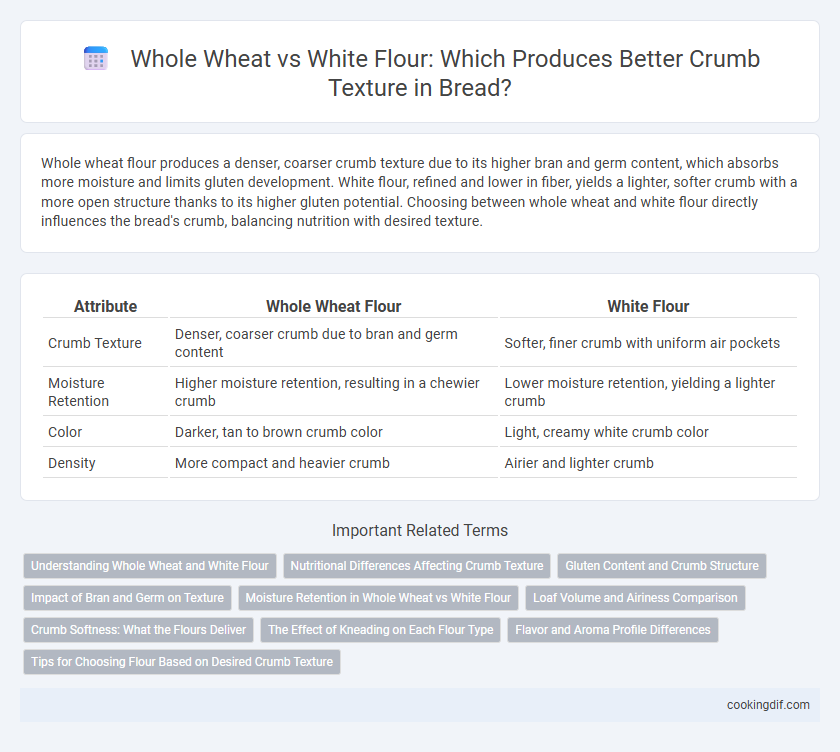Whole wheat flour produces a denser, coarser crumb texture due to its higher bran and germ content, which absorbs more moisture and limits gluten development. White flour, refined and lower in fiber, yields a lighter, softer crumb with a more open structure thanks to its higher gluten potential. Choosing between whole wheat and white flour directly influences the bread's crumb, balancing nutrition with desired texture.
Table of Comparison
| Attribute | Whole Wheat Flour | White Flour |
|---|---|---|
| Crumb Texture | Denser, coarser crumb due to bran and germ content | Softer, finer crumb with uniform air pockets |
| Moisture Retention | Higher moisture retention, resulting in a chewier crumb | Lower moisture retention, yielding a lighter crumb |
| Color | Darker, tan to brown crumb color | Light, creamy white crumb color |
| Density | More compact and heavier crumb | Airier and lighter crumb |
Understanding Whole Wheat and White Flour
Whole wheat flour contains bran, germ, and endosperm, providing a denser crumb texture due to its higher fiber content and oil presence. White flour, primarily composed of endosperm, results in a lighter and airier crumb with a finer texture, favored for its ability to produce soft and fluffy bread. Understanding the structural differences between whole wheat and white flour is essential for predicting crumb density and moisture retention in bread baking.
Nutritional Differences Affecting Crumb Texture
Whole wheat flour contains higher fiber and bran content compared to white flour, which contributes to a denser, coarser crumb texture in bread due to the presence of intact grain components that disrupt gluten formation. White flour, primarily composed of refined endosperm, produces a finer, softer crumb because of its lower fiber content and higher protein availability that enhances gluten network development. The nutritional differences, specifically fiber and protein levels, directly influence moisture retention and crumb structure, making whole wheat breads more substantial and white breads lighter.
Gluten Content and Crumb Structure
Whole wheat flour contains higher gluten levels than white flour, contributing to a denser and chewier crumb texture in bread. The bran and germ in whole wheat disrupt gluten network formation, resulting in a more compact crumb structure with less rise and airiness. In contrast, white flour's refined nature allows for a stronger gluten network, producing a lighter, softer, and more open crumb ideal for delicate bread varieties.
Impact of Bran and Germ on Texture
Whole wheat flour contains bran and germ, which contribute to a denser, coarser crumb texture due to their high fiber content disrupting gluten development. In contrast, white flour is refined with bran and germ removed, resulting in a finer, softer crumb as gluten forms more evenly. The presence of bran and germ in whole wheat flour enhances nutritional value but reduces crumb softness and volume compared to white flour.
Moisture Retention in Whole Wheat vs White Flour
Whole wheat flour retains more moisture than white flour due to its higher bran and germ content, resulting in a denser crumb texture with enhanced softness. The presence of bran particles in whole wheat flour absorbs and holds water more effectively, maintaining freshness longer compared to the lighter, drier crumb of white flour bread. This moisture retention contributes to a more moist and hearty crumb, important for improving the overall eating experience and shelf life of whole wheat bread.
Loaf Volume and Airiness Comparison
Whole wheat flour produces denser crumb texture and lower loaf volume due to higher fiber content that inhibits gluten development, resulting in less airiness. White flour, with refined bran and germ removed, promotes stronger gluten networks that trap more gas, yielding lighter, fluffier bread with greater oven spring. Bakers seeking soft, airy loaves typically prefer white flour, while whole wheat's rustic texture appeals in heartier, compact breads.
Crumb Softness: What the Flours Deliver
Whole wheat flour produces a denser crumb texture due to higher fiber and bran content, which absorbs more water and limits gluten development, resulting in a chewier, less soft bread. White flour, with its refined starch and lower protein, promotes a lighter, airier crumb that yields a softer bite because of increased gluten elasticity and moisture retention. The choice between whole wheat and white flour directly impacts crumb softness, with white flour delivering a tender, soft texture while whole wheat offers a heartier, more substantial feel.
The Effect of Kneading on Each Flour Type
Kneading whole wheat flour develops its bran and germ components, resulting in a denser crumb with a coarser texture due to limited gluten network formation. White flour, with higher gluten content and absent bran, responds to kneading by creating a stronger dough structure that traps air, producing a softer and more open crumb. Proper kneading techniques are essential for optimizing crumb texture specific to each flour type's gluten development and hydration properties.
Flavor and Aroma Profile Differences
Whole wheat flour produces bread with a denser crumb texture and a richer, nuttier flavor compared to white flour, which yields a lighter, softer crumb and a milder taste. The bran and germ in whole wheat contribute to a more complex aroma profile featuring earthy and slightly sweet notes, while white flour's refined nature results in a cleaner, subtler aroma. The flavor intensity and aromatic depth of whole wheat bread make it distinctively heartier than the more neutral and delicate profile of white bread.
Tips for Choosing Flour Based on Desired Crumb Texture
Whole wheat flour produces a denser crumb with a nuttier flavor due to its higher fiber content and bran inclusion, ideal for rustic, hearty bread. White flour yields a lighter, softer crumb with a finer texture, perfect for tender sandwich loaves and pastries. For achieving specific crumb textures, blend whole wheat and white flour or adjust hydration and kneading techniques to balance density and softness.
Whole Wheat vs White Flour for crumb texture Infographic

 cookingdif.com
cookingdif.com